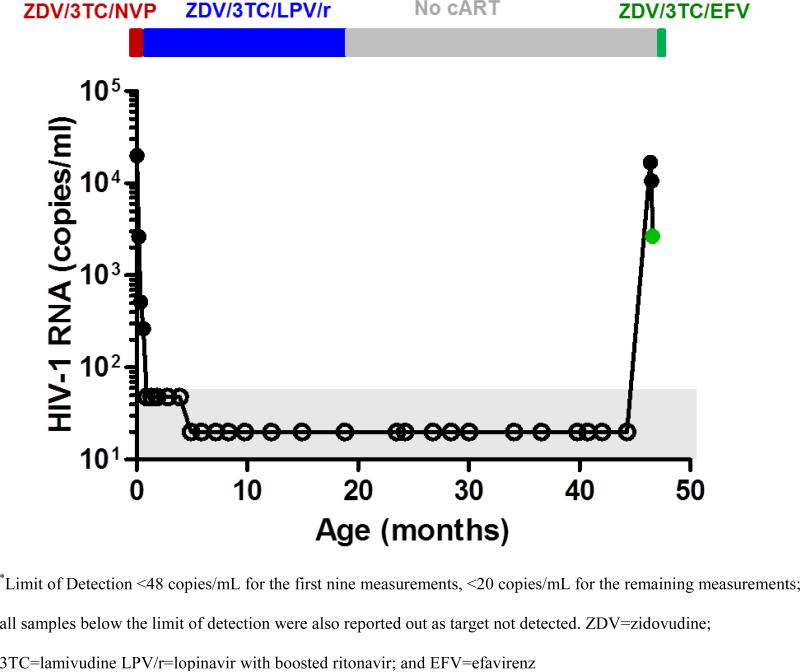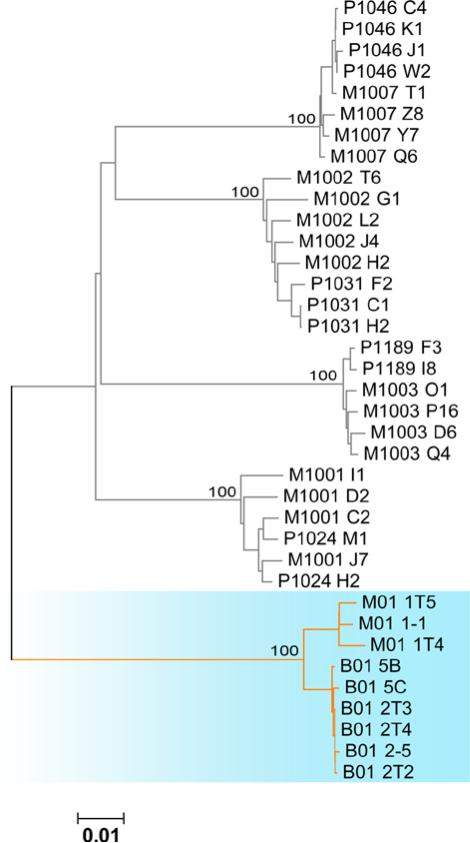We previously reported1 the first well-defined case of HIV-1 remission in a perinatally-infected child – the “Mississippi Child”. After receiving antiretroviral therapy (ART) between 30 hours to 18 months of age, this child had persistently undetectable plasma viremia for 12 months in the absence of HIV-1-specific immune responses. At the time of the initial case report, it was uncertain whether HIV-1 reservoirs were established that could lead to rebound viremia.
After the first report, the child had persistently undetectable plasma RNA levels using standard clinical assays, with normal CD4+ and CD8+ T-cell counts .Plasma viremia also remained undetectable through 21.9 months off ART by ultrasensitive single copy viral load assays at <0.4 and 0.5 copies/mL.
During routine clinical follow-up at 46.4 months of age, the plasma viral load rebounded to 16,750 copies/mL after 27.6 months off ART; this was confirmed with repeat testing (Figure 1). The child did not have symptoms or signs of acute retroviral syndrome or incident illnesses (including EBV and CMV) and had not received any vaccines. Epidemiologic risk factors for reinfection with HIV-1 through breast milk, pre-masticated food, or sexual abuse were investigated and excluded. Within 72 hours of re-initiating ART, the plasma viral load dropped to 2,658 copies/mL (Figure 1), circulating CD4+ T-cell levels increased to 43%, and the CD4+:CD8+ T-cell ratio normalized.
Figure 1. Clinical Viral Load off Antiretroviral Treatment.
*Limit of Detection <48 copies/mL for the first nine measurements, <20 copies/mL for the remaining measurements; all samples below the limit of detection were also reported out as target not detected. ZDV=zidovudine; 3TC=lamivudine LPV/r=lopinavir with boosted ritonavir; and EFV=efavirenz
During the period of virologic remission, HIV-1 DNA was intermittently detected in circulating unfractionated PBMC and cells enriched for resting and activated CD4+ T-cells. HLA-typing confirmed the patient identity of the cellular DNA used for HIV-1 DNA measurements (data not shown). Median copies of HIV-1 DNA in unfractionated PBMC and resting and activated CD4+ T-cells prior to rebound viremia were 2.7 (IQR 2.2, 3.4), 3.5 (IQR 2.1, 4.4), and 3.3 (IQR 1.8, 5.5) per million cells, respectively. However, replication-competent viral reservoirs remained undetectable throughout follow-up in a cumulative 64 million cultured resting CD4+ T-cells.
HIV-1-specific antibody and cell-mediated immune responses were not detected through 21.9 months off ART but were detected at viremic rebound by ELISA and confirmed by Western blot (1:10 dilution) with reactivity to HIV-1 Env (gp160) and Gag (p24); 72 hours later, Western blot testing revealed reactivity to HIV-1 Env (gp160,gp120,gp41), Gag (p55,p24,p17) and polymerase (Pol,p66). The lack of detectable responses to p31 integrase was compatible with rebound viral replication of at least 1 month but less than 2 months.2
Prior to viremic rebound, sequencing attempts were unsuccessful. Single genome amplification and sequencing of full-length HIV-1 Env directly from rebounding plasma virus revealed 98.6% sequence identity to maternal plasma viral sequences collected 24 months post-delivery (Figure 2). Diversity was 0.1%, consistent with values seen in transmitted founder viruses in mother-to-child HIV-1 transmission3, 4 and a lack of ongoing virus replication during the period of HIV-1 remission. Phenotypic and genotypic analysis of the HIV-1 Env sequence from rebounding virus showed R5-tropism.
Figure 2. Phylogenetic Analyses of Infant Rebound Plasma and Maternal Plasma Viral Sequences Amplified from Blood Collected 24 Months Prior to Rebound.
Neighbor-joining tree depicts full-length gp160 env sequences. Four previously described HIV-1 clade B-infected mother/infant pairs 3 are included in the analysis for comparison of inter-patient diversity and relatedness between mother and infant.
In conclusion, the return of HIV-1 viremia after a substantial period of viral quiescence is consistent with the model of HIV-1 latency in which long-lived resting memory CD4+ T-cells were generated during routine immunologic memory formation5, though other reservoirs are also possible. To the best of our knowledge, this child received ART between 30 hours and 18 months of age. Whether earlier initiation or a longer duration of ART, alone or combined with immunotherapeutic strategies, would have further extended the duration of remission is unknown. Although unfortunate for this child, the findings in this case and others6, 7 provide important new information on how very early treatment may markedly restrict but not eradicate HIV-1 reservoirs. Additional studies are underway to test this hypothesis and to determine whether ART alone will enable long-term HIV-1 remission or cure. Until these studies are completed, initiation of antiretroviral therapy as early as possible in infants and continuation without interruption seems prudent.
ACKNOWLEDGEMENTS
We thank the family of the child discussed in this article, who agreed to the presentation of this case in order to advance medical knowledge. We gratefully acknowledge Linda Lambrecht, Joyce Pepe, Robin Brody and Ya Hui Chen for technical support, Margaret McManus for assistance with data analysis, Margaret A. Bedison and Dianna L. Koontz for performing iSCA assays. Funding for this project was provided in by: RO1 HD080474 (DP), JHU-CFAR [P30AI094189] (DP), and an IMPAACT Subspecialty grant [UM1 AI106716] (DP); AI1097265 (KL), F32 AI108414 (KBS), and the UMass Center for Clinical and Translational Science [UL1TR000161] (KL), all from the National Institutes of Health. JWM receives support by a grant from the AIDS Clinical Trials Group to the Pittsburgh Virology Specialty Laboratory (UM1AI106701) and from Leidos Biomedical Research, Inc. Contract 12XS547 through the National Cancer Institute. The content of this publication does not necessarily reflect the views or policies of the Department of Health and Human Services, nor does mention of trade names, commercial products, or organizations imply endorsement by the U.S. Government.
Reference List
- 1.Persaud D, Gay H, Ziemniak C, et al. Absence of detectable HIV-1 viremia after treatment cessation in an infant. N Engl J Med. 2013;369(19):1828–1835. doi: 10.1056/NEJMoa1302976. [DOI] [PMC free article] [PubMed] [Google Scholar]
- 2.Tomaras GD, Haynes BF. HIV-1-specific antibody responses during acute and chronic HIV-1 infection. Curr Opin HIV AIDS. 2009;4(5):373–379. doi: 10.1097/COH.0b013e32832f00c0. [DOI] [PMC free article] [PubMed] [Google Scholar]
- 3.Kishko M, Somasundaran M, Brewster F, Sullivan JL, Clapham PR, Luzuriaga K. Genotypic and functional properties of early infant HIV-1 envelopes. Retrovirology. 2011;8:67. doi: 10.1186/1742-4690-8-67. [DOI] [PMC free article] [PubMed] [Google Scholar]
- 4.Wolinsky SM, Wike CM, Korber BT, et al. Selective transmission of human immunodeficiency virus type-1 variants from mothers to infants. Science. 1992;255(5048):1134–1137. doi: 10.1126/science.1546316. [DOI] [PubMed] [Google Scholar]
- 5.Blankson JN, Persaud D, Siliciano RF. The challenge of viral reservoirs in HIV-1 infection. Annu Rev Med. 2002;53:557–593. doi: 10.1146/annurev.med.53.082901.104024. [DOI] [PubMed] [Google Scholar]
- 6.Butler KM, Gavin P, Coughlan S, et al. Rapid Viral Rebound after 4 Years of Suppressive Therapy in a Seronegative HIV-1 Infected Infant Treated from Birth. Pediatr Infect Dis J. 2014 doi: 10.1097/INF.0000000000000570. [DOI] [PubMed] [Google Scholar]
- 7.Giacomet V, Trabattoni D, Zanchetta N, et al. No cure of HIV infection in a child despite early treatment and apparent viral clearance. Lancet. 2014;384(9950):1320. doi: 10.1016/S0140-6736(14)61405-7. [DOI] [PubMed] [Google Scholar]




